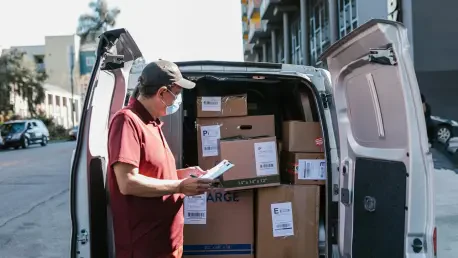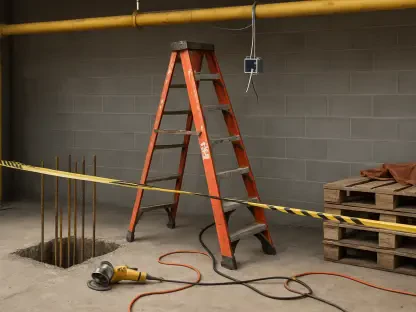In today’s rapidly evolving supply chain landscape, the emphasis on proactive safety measures has gained unprecedented importance, urging a significant shift from traditional reactive strategies. The persistent high rate of workplace fatalities and injuries highlights the urgent need for a new approach. Merely reacting to incidents after they occur can no longer suffice, showing persistent flaws in safeguarding employees and assets. As industry leaders increasingly acknowledge the linkage between proactive safety protocols, operational efficiency, and financial prosperity, a comprehensive transformation becomes indispensable. This push toward preventive measures not only aims to improve worker safety but is poised to redefine business models, embedding safety as an integral component of strategic growth and profitability.
The Shift from Reactive to Proactive Safety
Traditional methods predominantly focus on post-incident investigations followed by corrective actions, operating in a cycle characterized by delays and inefficiencies. Between investigations, businesses remain vulnerable to repeat occurrences, leading to stagnation in progress towards mitigating risks. In 2025, the transition from these methods to proactive safety systems is crucial, aiming to anticipate and avert incidents through innovative measures and forward-thinking strategies. These advanced systems emphasize continuous monitoring and identification of potential hazards, adopting technologies such as Computer Vision (CV) and Artificial Intelligence (AI) to scrutinize complex operational variables in real-time. This contemporary approach seeks not merely to comply with regulations but to embed safety within the culture of organizations.
Furthermore, the paradigm shift endorses the use of predictive analytics, allowing organizations to map habitual risks that occur across various operational environments, ensuring a systemic resolution rather than isolated problem-solving. Proactive safety frameworks recognize patterns, predict potential points of failure, and implement interventions before threats materialize. By embracing this forward-looking stance, businesses can generate a culture of safety embedded within their operations. Leaders are encouraged to prioritize high-risk areas initially, progressively extending proactive measures to all facets of their operations. Incorporating accountability across different organizational tiers ensures sustained commitment and engagement, harnessing both technical expertise and human insight to drive meaningful change.
Financial Implications and Operational Benefits
A critical analysis reveals the pervasive influence of safety practices on the financial health of supply chains, underscoring the substantial costs associated with reactive approaches. Direct expenses such as compensation, medical treatments, and regulatory penalties are considerable; however, indirect costs, frequently overshadowed, are often more detrimental. These include losses in workforce productivity, elevated training expenses, damaged equipment, and loss of consumer confidence, each contributing to a suppressed bottom line. Proactive measures aim to curb these indirect expenses by preventing incidents altogether, enhancing operational workflows, and improving overall employee morale.
Moreover, proactive methods provide substantial operational advantages, where safety becomes synonymous with efficiency and quality. Firms transcend traditional metrics like Total Recordable Incident Rate (TRIR) and Days Away, Restricted, or Transferred (DART), focusing on future-proof systems that integrate safety seamlessly. Enhanced safety mechanisms streamline operations by reducing disruptions, minimizing redundancies, and fostering a resilient workforce finely attuned to preventative practices. Such strategic alignment elevates not just safety standards but operational performance, driving revenue growth and ensuring competitive sustainability. Organizations investing in robust safety systems invariably attract and retain talented personnel, enriching the company’s ethos and long-term strategic objectives.
Leveraging Technology for Strategic Advantage
The ongoing technological evolution presents a compelling opportunity for the supply chain industry to embrace solutions that reimagine safety protocols. Technologies like Artificial Intelligence and Computer Vision lead the charge in establishing proactive frameworks capable of identifying risks unseen by the human eye. Real-time surveillance empowers businesses to preemptively address unsafe behaviors, environmental hazards, and compliance lapses. These innovations offer a transformative edge, converting expansive data sets into actionable intelligence scalable across divisions and industries. Technologies cater to a holistic approach to safety, enhancing traditional methodologies through precise insights and systemic analysis.
By harnessing the potential of predictive analytics, organizations unlock the capability to predict and prioritize systemic risks meaningfully, aligning resources and expertise with areas demanding immediate attention. This integration of technology fosters an environment where safety surpasses regulatory compliance, evolving into a strategic asset, integral to business development. Leaders adopting these technological advancements ensure a competitive edge, adapting swiftly to market demands while mitigating operational hazards effectively. The shift to technologically advanced safety solutions positions supply chains to thrive, enhancing resilience, optimizing product quality, and promoting robust customer relationships.
Strategic Integration and Cultural Considerations
For supply chains to successfully incorporate proactive safety systems, a comprehensive strategy involving technology, organizational change, and human resources must be established. The effective implementation of these systems relies on transparent communication, wherein stakeholders understand not only the technical aspects but the cultural shifts required for successful adoption. Ensuring active participation from frontline workers is key; their insights into day-to-day operations can guide realistic and applicable safety protocols. Leadership must advocate for positive safety perceptions, shifting from compliance to proactive engagement, thus embedding safety across organizational culture.
Fundamentally, change management must prioritize transparent communication channels, fostering involvement and acceptance at all levels. Balancing technological solutions with human expertise is crucial, ensuring seamless adaptation to new procedures. Establishing accountability and rewarding innovations in safety can transform employee attitudes toward protocol adherence, boosting morale and engagement. Organizations that successfully navigate this integration foster a culture of innovation and inclusivity, where safety becomes both a shared responsibility and strategic asset. In embracing this cultural evolution, supply chains set themselves apart in an increasingly competitive market landscape.
Strategic Investment for Future Growth
Traditional methods for addressing safety often involve post-incident investigations followed by corrective actions, operating in a cycle marked by delays and inefficiencies. These methods expose businesses to repeated incidents, hindering progress toward risk mitigation. By 2025, transitioning to proactive safety systems is pivotal, aiming to predict and prevent incidents through innovative approaches. These systems prioritize constant monitoring for potential hazards, employing technologies like Computer Vision (CV) and Artificial Intelligence (AI) to analyze intricate operational dynamics in real-time. This new method goes beyond merely meeting regulations, embedding safety into the organizational culture.
The shift embraces predictive analytics, enabling companies to identify common risks across diverse environments for comprehensive solutions rather than isolated fixes. Proactive safety frameworks anticipate trouble areas, allowing businesses to intervene before issues arise. Establishing safety as a core value of operations begins with addressing high-risk areas and spreading preventive measures throughout. Accountability at all organizational levels ensures ongoing engagement and commitment, using technical expertise and human insight to foster substantial change.









